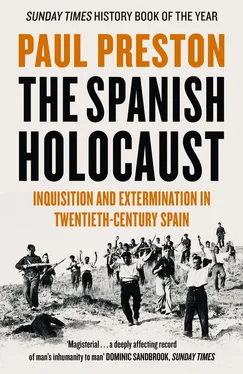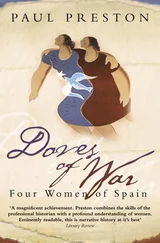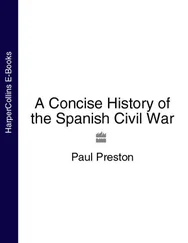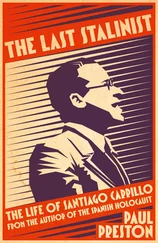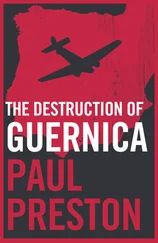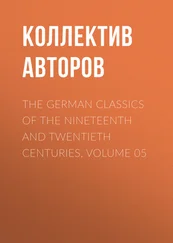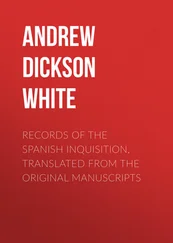As part of the campaign a group of Basque Traditionalists created the Association of Relatives and Friends of Religious Personnel. The Association attracted considerable support in Salamanca and Valladolid, towns notable for the ferocity of the repression during the Civil War. It published an anti-Republican bulletin, Defensa, and many anti-Republican pamphlets. It also founded the violently anti-Masonic and anti-Semitic weekly magazine Los Hijos del Pueblo under the editorship of Francisco de Luis, who would eventually run El Debate in succession to Ángel Herrera Oria. De Luis was a fervent advocate of the theory that the Spanish Republic was the plaything of an international Jewish–Masonic–Bolshevik conspiracy. 38Another leading contributor to Los Hijos del Pueblo was the integrist Jesuit Father Enrique Herrera Oria, brother of Ángel. The paper’s wide circulation was in large part a reflection of the popularity of its vicious satirical cartoons attacking prominent Republican politicians. Presenting them as Jews and Freemasons, and thus part of the international conspiracy against Catholic Spain, it popularized among its readers the notion that this filthy foreign plot had to be destroyed. 39
The idea that leftists and liberals were not true Spaniards and therefore had to be destroyed quickly took root on the right. In early November 1931, the monarchist leader Antonio Goicoechea declared to a cheering audience in Madrid that there was to be a battle to the death between socialism and the nation. 40On 8 November, the Carlist Joaquín Beunza thundered to an audience of 22,000 people in Palencia: ‘Are we men or not? Those not prepared to give their all in these moments of shameless persecution do not deserve the name Catholic. We must be ready to defend ourselves by all means, and I don’t say legal means, because all means are good for self-defence.’ Declaring the Cortes a zoo, he went on: ‘We are governed by a gang of Freemasons. And I say that against them all methods are legitimate, both legal and illegal ones.’ At the same meeting, Gil Robles declared that the government’s persecution of the Church was decided ‘in the Masonic lodges’. 41
Incitement to violence against the Republic and its supporters was not confined to the extreme right. The speeches of the legalist Catholic Gil Robles were every bit as belligerent and provocative as those of monarchists, Carlists and, later, Falangists. At Molina de Segura (Murcia) on New Year’s Day 1932, Gil Robles declared: ‘In 1932 we must impose our will with the force of our rightness, and with other forces if this is insufficient. The cowardice of the Right has allowed those who come from the cesspools of iniquity to take control of the destinies of the fatherland.’ 42The intransigence of more moderate sections of the Spanish right was revealed by the inaugural manifesto of the Juventud (youth movement) de Acción Popular which proclaimed: ‘We are men of the right … We will respect the legitimate orders of authority, but we will not tolerate the impositions of the irresponsible rabble. We will always have the courage to make ourselves respected. We declare war on communism and Freemasonry.’ In the eyes of the right, ‘communism’ included the Socialist Party and Freemasonry signified the various Republican liberal parties and their regional variants known as Left Republicans. 43
Justification for hostility to the Republic could easily be found in its efforts to secularize society. Distress had been caused by the fact that municipal authorities were forbidden to make financial contributions to the Church or its festivals. In January 1932, Church cemeteries came under municipal jurisdiction. The state now recognized only civil marriage, so those who had a Church wedding also had to visit a registry office. Burial ceremonies were to have no religious character unless the deceased, being over the age of twenty, had left specific instructions to the contrary, something involving complicated bureaucracy for relatives. 44
In May 1932, during the feast of San Pedro Mártir in Burbáguena (Teruel), a brass band played in the town square, thereby deliberately clashing with the religious music being sung in the church in honour of the saint. In Libros (Teruel), a dance was organized outside the parish church while a mass was being said in honour of the Virgen del Pilar. 45In Seville, fear of attack led to more than forty of the traditional fraternities (cofradías) withdrawing from the Holy Week procession. Their members were predominantly militants of Acción Popular and of the Carlist Comunión Tradicionalista and their gesture popularized among right-wing Catholics the phrase ‘Seville the martyr’, despite the fact that every effort was made by Republican authorities to see the processions go ahead. Vociferous complaints came from the same men who were also prominent in employers’ and landowners’ organizations. In the event, only one cofradía marched and was the target of insults and stones. Some days later, on 7 April 1932, the Church of San Julián was burned down. 46
Some local municipalities removed crucifixes from schools and religious statues from public hospitals as well as prohibiting the ringing of bells. Such measures went beyond official government policy, which was that municipal permission was required for public ceremonies. Perceived as persecution, they caused ordinary Catholics to see the Republic as their enemy. In many villages in the province of Salamanca, there were street protests and children were kept away from school until the crucifixes were returned. Ordinary Catholics were upset when, in late September 1932, the ringing of church bells was prohibited in Béjar for mass, weddings or funerals. Elsewhere, many left-wing alcaldes (mayors) levied a local tax on bell-ringing. 47In Talavera de la Reina (Toledo), the Mayor imposed fines on women wearing crucifixes. In the socially conflictive province of Badajoz, numerous incidents, such as the prohibition of funeral processions, incited hatred. In Fuente de Cantos, the Mayor imposed a tax on bell-ringing of 10 pesetas for the first five minutes and 2 pesetas for every minute thereafter. In Fregenal de la Sierra, bell-ringing was forbidden altogether and a tax levied on Catholic burials. There were church burnings in several villages. In Villafranca de los Barros, the Socialist majority of the town council voted in April 1932 for the removal of the statue of the Sacred Heart from the main square. 48
Religious frictions were quickly exploited by the right. Processions became demonstrations, pilgrimages became protest marches, and Sunday sermons became meetings which often provoked anti-clerical reactions, sometimes violent. 49It was but a short step from the rhetoric of persecution and suffering to the advocacy of violence against Republican reforms portrayed as the work of a sinister foreign Jewish–Masonic–Bolshevik plot. 50In later years, Gil Robles would admit that he had deliberately set out to push his audiences towards conflict with the authorities. In April 1937, when Acción Popular was being dissolved and incorporated by Franco into his new one-party state, Gil Robles claimed proudly that the reserves of mass rightist belligerence which he had built up during the Republic made possible the victory of the right in the Civil War. He saw this ‘splendid harvest’ as the fruit of his own propaganda efforts. He was still taking pride in this achievement when he published his memoirs in 1968. 51
Gil Robles’s rhetoric during the Republic reflected the feelings and the fears of his most powerful backers, the big landowners or latifundistas. Their outrage at the sheer effrontery of landless labourers in daring to take part in the revolutionary upheavals of 1918–21 reflected their sense of social, cultural and indeed near-racist superiority over those who worked their estates. That the Republican–Socialist coalition should declare its intention to improve the daily lot of the wretched day-labourers implied a sweeping challenge to the very structures of rural power. The hostility of the landowners towards the new regime was first manifested in a determination to block Republican reforms by any means, including unrestrained violence. The hatred of the latifundistas for their braceros would find its most complete expression in the early months of the Civil War when they would collaborate enthusiastically with Franco’s African columns as they spread a wave of terror through south-western Spain.
Читать дальше
